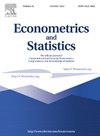New estimation approaches for graphical models with elastic net penalty
IF 2.5
Q2 ECONOMICS
引用次数: 0
Abstract
In the context of undirected Gaussian graphical models, three estimators based on elastic net penalty for the underlying dependence graph are introduced. The aim is to estimate a sparse precision matrix, from which to retrieve both the underlying conditional dependence graph and the partial correlations. The first estimator is derived from the direct penalization of the precision matrix in the likelihood function, while the second uses penalized regressions to estimate the precision matrix. Finally, the third estimator relies on a two stage procedure that estimates the edge set first and then the precision matrix elements. Through simulations the performances of the proposed methods are investigated on a set of well-known network structures. Results on simulated data show that in high-dimensional situations the second estimator performs relatively well, while in low-dimensional settings the two stage procedure outperforms most estimators as the sample size grows. Nonetheless, there are situations where the first estimator is also a good choice. Mixed results suggest that the elastic net penalty is not always the best choice when compared to the LASSO penalty, i.e. pure penalty, even if elastic net penalty tends to outperform LASSO in presence of highly correlated data from the cluster structure. Finally, using real-world data on U.S. economic sectors, dependencies are estimated and the impact of Covid-19 pandemic on the network strength is studied.
具有弹性网惩罚的图形模型的新估计方法
针对无向高斯图模型,介绍了基于弹性网惩罚的三种底层依赖图估计器。目的是估计一个稀疏精度矩阵,从中检索潜在的条件依赖图和部分相关性。第一个估计量来自于似然函数中精度矩阵的直接惩罚,而第二个估计量使用惩罚回归来估计精度矩阵。最后,第三个估计器依赖于一个两阶段的过程,首先估计边缘集,然后估计精度矩阵元素。通过仿真,在一组已知的网络结构上研究了所提方法的性能。模拟数据的结果表明,在高维情况下,第二阶段估计器的性能相对较好,而在低维情况下,随着样本量的增加,两阶段过程的性能优于大多数估计器。尽管如此,在某些情况下,第一估计器也是一个不错的选择。混合结果表明,弹性网惩罚并不总是与LASSO惩罚(即纯1惩罚)相比的最佳选择,即使弹性网惩罚倾向于在集群结构中存在高度相关的数据时优于LASSO。最后,利用美国经济部门的真实数据,估计了依赖性,并研究了Covid-19大流行对网络强度的影响。
本文章由计算机程序翻译,如有差异,请以英文原文为准。
求助全文
约1分钟内获得全文
求助全文
来源期刊

Econometrics and Statistics
ECONOMICS-
CiteScore
3.10
自引率
10.50%
发文量
84
期刊介绍:
Econometrics and Statistics is the official journal of the networks Computational and Financial Econometrics and Computational and Methodological Statistics. It publishes research papers in all aspects of econometrics and statistics and comprises of the two sections Part A: Econometrics and Part B: Statistics.
 求助内容:
求助内容: 应助结果提醒方式:
应助结果提醒方式:


